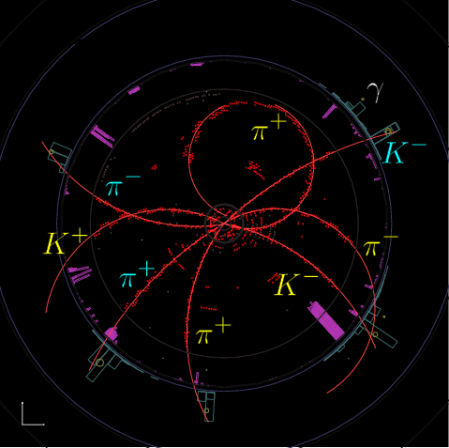The last* CLEO-c double tag event
March 7, 2008
(* last = last confidently-identified fully-reconstructed Ds Ds* event)
CLEO-c stopped taking data earlier this week. We looked in the last data run (7:38 am to 8 am) of just over 61 thousand events for collisions that produced Ds mesons, and we actually found one. Even better, we found an event where you could see both the Ds+ and Ds–, and where the photon from the Ds*+ → γ Ds+ transition was visible. Above, you can see the event display, with all the tracks labeled; the event is consistent with the following sequence of events:
- e+ e– → γ → Ds*+ Ds–
- Ds*+ → γ Ds+
- Ds+ → K– K+ π+ π+ π–
- Ds– → KS K–
- KS → π+ π–
- Ds*+ → γ Ds+
It was actually unlikely that we’d find such a nice event. For the amount of data in the last run, we would expect roughly 75 Ds* Ds events. Our full reconstruction efficiency (getting both Ds candidates) is somewhat less than 1%, so we had a good chance of winding up with zero events like this. It’s nice to be lucky though.
So long and thanks for all the events
March 3, 2008
The original incarnation of the CLEO detector first started looking at the products of e+ e– collisions in 1979; the latest (and last) version, CLEO-c, recorded its last event at 8 am Eastern today – an electron and a positron bouncing off each other. Along the way, 450 papers have been published on CLEO data. We had a little celebration in the counting room as the last run, 234607, ended:
There’s still a lot of work to do – we need to decommission CLEO and reconstruct and analyze the last data!
